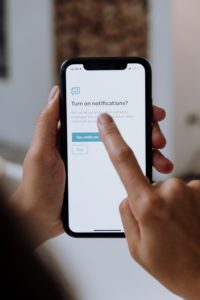As a teacher or consultant, you’ve probably spent countless evenings and even weekends working on activities for your students, scouring the internet for inspiring ideas or getting to know the newest robot or coding program. Setting boundaries and establishing a healthy work-life balance can be challenging, especially when you work in the field of education. It is normal to want to give your students the best education possible. However, if you let it, teaching can quickly take over your life. While spending a few evenings throughout the year prepping ultra-fun and educational activities is fine, extending your work hours into the evening should not be normalized. You need and deserve a life outside of the classroom. It doesn’t make you any less of a teacher. It doesn’t mean you don’t care about your students. You merely need to take care of yourself first – just like on an airplane, a few minutes before take-off when the flight attendant explains that you need to put the oxygen mask on yourself first before you can help others. While this might sound selfish, you’re ensuring that you’re at your best and energized to be able to guide and help others. As a teacher, that can mean keeping a healthy work-life balance.
Educational technology can be useful for taking that step towards setting boundaries and establishing balance. Let’s discuss how we can use technology to improve our overall wellness without forgoing our passion for the profession and commitments to our students and broader communities.
Set Work Hours
 As devoted as you may be, teaching doesn’t require you to be available 24/7. While it can be difficult to find time to follow up on situations during the day, that doesn’t mean that you have to spend your evening responding to students’ and parents’ messages on ‘Class Dojo’.
As devoted as you may be, teaching doesn’t require you to be available 24/7. While it can be difficult to find time to follow up on situations during the day, that doesn’t mean that you have to spend your evening responding to students’ and parents’ messages on ‘Class Dojo’.
While there are lots of benefits to applications that facilitate parent-teacher and teacher-student communication, one downside is that they can make you feel obligated to be available around the clock. One recommendation is to adjust the notification setting or setting downtime for these types of work applications. It can be tempting to send parents a short message in the evening to tell them about a school activity or how their child did during the day, but these messages often tend to take more time than initially planned and open the door for parents and students to reply to you during off hours.
Don’t want parents or students to think that you’re being rude or ignoring them if you don’t immediately respond to their messages? Tell them about your screen time limits and why they are important to you. This information will not only help them to respect your boundaries, but it will also give them an indicator of what to expect with regard to response time. Plus, you’ll be nurturing digital competency by modeling and explicitly teaching about screen time and media balance.
Do more with less
Despite the temptation of novelty, you don’t need a new activity or center for every lesson. It is easy to lose a whole prep period scrolling through endless online resources. You can save time by not reinventing the wheel every day.
Reusing an activity is less time-consuming and encourages students to dive deeper into content, ask more questions, and solidify concepts. When you find a good website, resource, or worksheet, bookmark it (or add it to a Wakelet, Padlet, or Pinterest Board) and revisit the resources throughout the year. Having these resources on ‘Tab’, and organized online will help reduce your prep time!
Along the same lines, you don’t need to grade everything, and you can use technology to help you provide ongoing feedback. Emojis, Bitmojis, GIFs, and audio recordings are quick formative assessment tools that can enhance what you are already doing in class. You could also use tools that give instant feedback to students, like Kahoot! or Quizlet. Less grading means more time for teacher reflection and preparation.
This last bit might seem controversial, but fewer or no worksheets can benefit you and your students. Students’ learning isn’t proportional to the number of worksheets they complete or how “cute” the worksheets look. Even the simplest of worksheets takes a surprising amount of time to create, print and staple, especially if you encounter one of those beloved paper jams. Searching the internet for the perfect worksheet can also be unexpectedly time-consuming. You do not need a paper to prove that your students practiced or learned something. Recordings, reflections, drawings, and portfolios are also valid evidence. They also tend to be more engaging, less time-consuming, and more effective. If you absolutely need a worksheet, try finding or creating a template. Templates may help you spend less time making and more time providing valuable feedback to students.
Don’t Fixate on Having a Pinterest/Instagram-Worthy Classroom
Pinterest is often the go-to place for teachers. Those photos of outstanding lessons and super cute and organized classrooms can make you fuzzy!  However, those photos are utterly unrealistic unless you are a teacher who spends 10+ hours of your day laminating and re-organizing desks and displays. Your classroom does not have to look like Pinterest, and your worksheets don’t have to be filled with cute clips and borders. While you can appreciate a beautiful Pinterest classroom or activity, setting that up takes a tremendous amount of time. Learning can take place even in the messiest of classrooms; the important part is that the classroom reflects the students’ learning, not the teacher’s decorating skills.
However, those photos are utterly unrealistic unless you are a teacher who spends 10+ hours of your day laminating and re-organizing desks and displays. Your classroom does not have to look like Pinterest, and your worksheets don’t have to be filled with cute clips and borders. While you can appreciate a beautiful Pinterest classroom or activity, setting that up takes a tremendous amount of time. Learning can take place even in the messiest of classrooms; the important part is that the classroom reflects the students’ learning, not the teacher’s decorating skills.
Be Okay with Not Knowing Everything
Teachers and consultants are experts in teaching and learning – and not necessarily experts in knowing everything about everything. However, that pressure to know everything or appear as though we have all the answers is still present. When trying a new activity or presenting a new robot to your students, why not model that idea of “not knowing everything”. For example, you don’t have to spend countless hours during your evenings trying to figure out the specs of BeeBot or how to code conversations between sprites in Scratch. Discover concepts and new technology WITH your students. Chances are they’ll be teaching you, helping their peers, and feeling empowered.
There are different ways of using technology to support this student-centered learning approach and liberate the teacher from being the “all-knowing expert”. It’s important to model for students that it’s okay not to know everything. By teaching them strategies to research information, they too can become critical thinkers. For example, use existing online tutorials and available resources. You can also send your students to many of your curated resources and have them experiment hands-on or do their own research. For example, if you’re looking to try the Micro: bit with your students and you’ve never touched one, don’t put too much pressure on your shoulders to become an expert before introducing it to your students. Use existing resources to get you started and learn alongside your students. Here’s an example of a Micro:bit course you can follow with your students, or a Padlet of Micro:bit coding challenges to try out.
Build a Network & Tap into Expertise
Sylvia Duckworth, a veteran teacher and well-known “sketchnoter”, illustrates the importance for teachers to maintain a personal and professional learning network (see a sketchnote by Sylwia: 10 Reasons Why Every Teacher Needs a P.L.N. ). When you find your right network, you’ll be surrounded by like-minded educators who are motivated to share ideas, expertise, latest trends, and resources, to help you problem solve and reflect. Connecting with other educators can save you a significant amount of time in the long run, and make you feel less isolated. Over the past years, so many different online communities and networks have been created to support teachers. A few examples of networks hosted by the LEARN pedagogical team are the Quebec ScratchEd Meetups and the Outdoor Education sharing sessions. Educators are welcome to share their ideas or activities in order to inspire others, ask questions or even just listen to the conversations. In networking or sharing sessions like these, you’ll save so much time from having to find ideas and create new activities. Let yourself be inspired by other educators’ experiences. They are also great support systems.

Most school boards also have subject-specific consultants, as well as RÉCIT consultants for integrating technology in a pedagogical way. Consultants are banks of resources and ideas and usually love sharing knowledge, tips, and tricks. Don’t hesitate to ask them for professional development opportunities or to support you and your students. RÉCIT consultants can, for example, offer support with robotics and coding. You can find the directory of RÉCIT consultants on the Digital Competency in Action (DCA) website. The DCA site was created as a hub for educational technology resources for teachers and consultants, such as summaries of Ministry documents and measures, information on digital technology combos (creative spaces, educational robotics, and digital devices to support your integration of Quebec’s Digital Action Plan) and a library of resources to support your students and yourself.
Find Balance
We encourage you to reflect on your own practice and how you can prioritize your overall wellness. Keep in mind that it is normal for personal and professional obligations to fluctuate throughout the year. For example, you may find your workload more demanding around key points in the year, like report card time. While a work-life balance may be unrealistic to maintain daily, it is something that you may want to strive for over an extended period of time. There are lots of ways in which technology can support you in your wellness goals. We invite you to try new strategies and experiment with technology to lessen your workload and prioritize the things that matter most in your professional and personal lives.
Photo Credit:
Featured image: Markus Winkler on Unsplash





